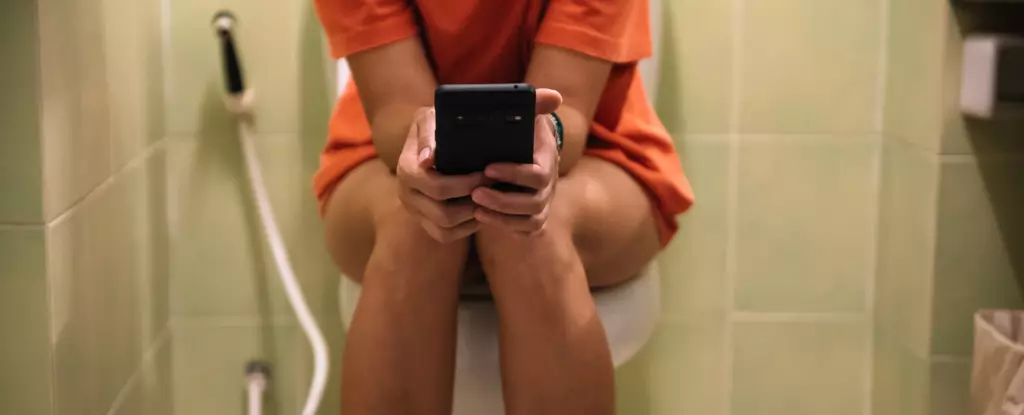In an age defined by unprecedented connectivity, the omnipresence of smartphones has changed how we engage with our daily routines—even in the most private, intimate spaces. The practice of reading or scrolling through social media while perched on the porcelain throne might seem innocuous, yet recent findings suggest this behavior may have detrimental consequences for our health. A recent survey presented at the Digestive Diseases Week (DDW) conference revealed alarming statistics: frequent smartphone use while in the bathroom increases the risk of developing hemorrhoids by a staggering 46%. This statistic isn’t just a wake-up call; it’s a compelling argument for re-examining what we do during those few quiet moments alone.
The implications of this survey’s findings go beyond numbers. With more than 40 percent of participants reporting hemorrhoids—and 93 percent admitting to smartphone use on the toilet—we face a critical juncture where modern convenience clashes with the realities of long-term health. The participants ranged widely in age, sex, and lifestyle choices, emphasizing that the danger isn’t limited to any single demographic. As smartphones become an extension of ourselves, we must confront the consequences of this digital companionship on our physical well-being.
Distraction Meets Duration: The Recipe for Disaster
Imagine sitting in a serene moment of solitude only to lose track of time while engrossed in an endless scroll of cat videos or news articles. The survey found that many respondents spent over six minutes on the toilet, attributing their prolonged visits to their phones. This habit of “toilet scrolling” could dilute the biological purpose of the bathroom visit, transforming it from a straightforward bodily function into an excuse for digital immersion. Prolonged sitting with no real objective can weaken and dilate the blood vessels located around the anal region, ultimately leading to those uncomfortable and painful hemorrhoids.
Medical professionals emphasize that the design of modern toilets might inadvertently contribute to an environment conducive to overstraining. With recommendations suggesting no more than 10 minutes—ideally three—for a bathroom visit, it’s evident that our habits may not align with expert advice. The irony lies in the fact that while we’re in a space devoted to excreting waste, we often engage instead in an exercise of mental accumulation: a dangerous contradiction that could affect our health down the line.
From the Past to the Present: A Reluctant Evolution
The historical perspective on toilet reading only complicates our modern relationship with hygiene and technology. In colonial American times, reading materials were scarce, and newspapers became multipurpose items that served both intellectual and practical needs. Today, however, the pernicious multitasking facilitated by smartphones turns what was once a matter of necessity into a perilous entitlement. The distractions of social media stress and news-feeding can result in a drastic shift in focus, steering our attention away from the vital act of mindful elimination.
As our society becomes increasingly digitized, it is essential to recognize how these changes affect our foundational practices. The stark contrast between how people previously approached toilet time and our current habits raises questions about whether this behavior could redefine what it means to maintain good hygiene. A team of researchers even advocates for a “smartphone-free zone” in our washrooms, arguing for a return to a time when toilets were primarily used for their intended biological purpose.
Health Implications and a Call to Action
While the survey highlights correlations rather than definitively established causations, the sheer volume of emergency room visits attributed to hemorrhoids—approximately 4 million annually—should be alarming. The condition itself, a combination of blood vessels, smooth muscle, and connective tissue, can both swell and bleed, leading many to suffer in silence due to their embarrassment surrounding such a private issue. Given that the last comprehensive U.S. national survey on hemorrhoids is nearly three decades old, the present-day urgency for more data is clear.
It’s evident that ongoing research is critical to understanding the nuanced relationship between toilet usage and the rise of hemorrhoids. Until such research is completed, individuals have the power to reclaim their health by adopting more mindful behaviors. In a world where social interaction and connectivity reign supreme, it is time to shift our priorities back toward what truly matters during those fleeting moments of relaxation. When nature calls, responding with efficiency should top our to-do lists over any virtual distractions that lead us astray.
In the end, while smartphones have granted us endless information at our fingertips, we must recognize that every indulgence has its price, and in this case—your health might be the cost of your next significant scrolling session.


Leave a Reply